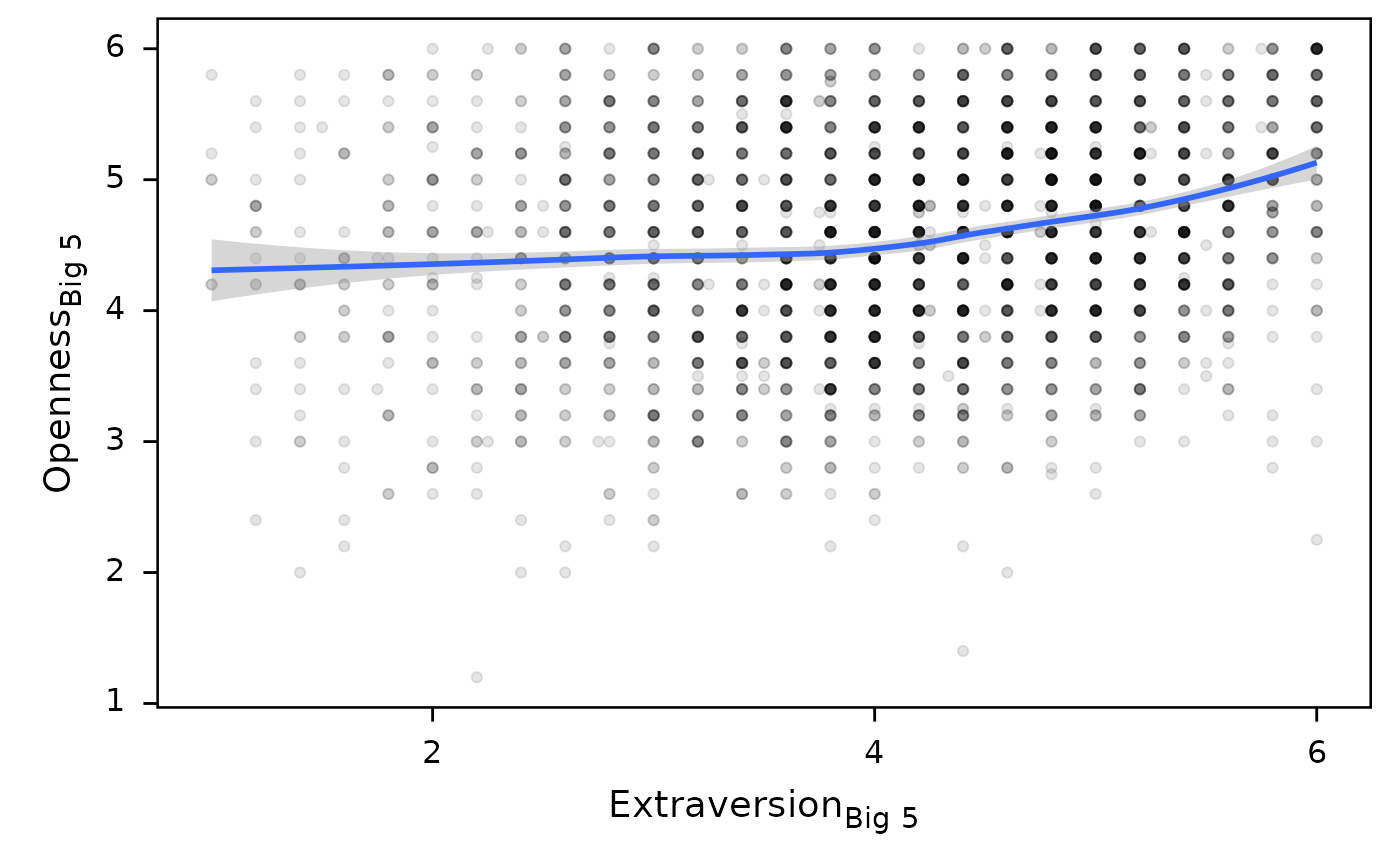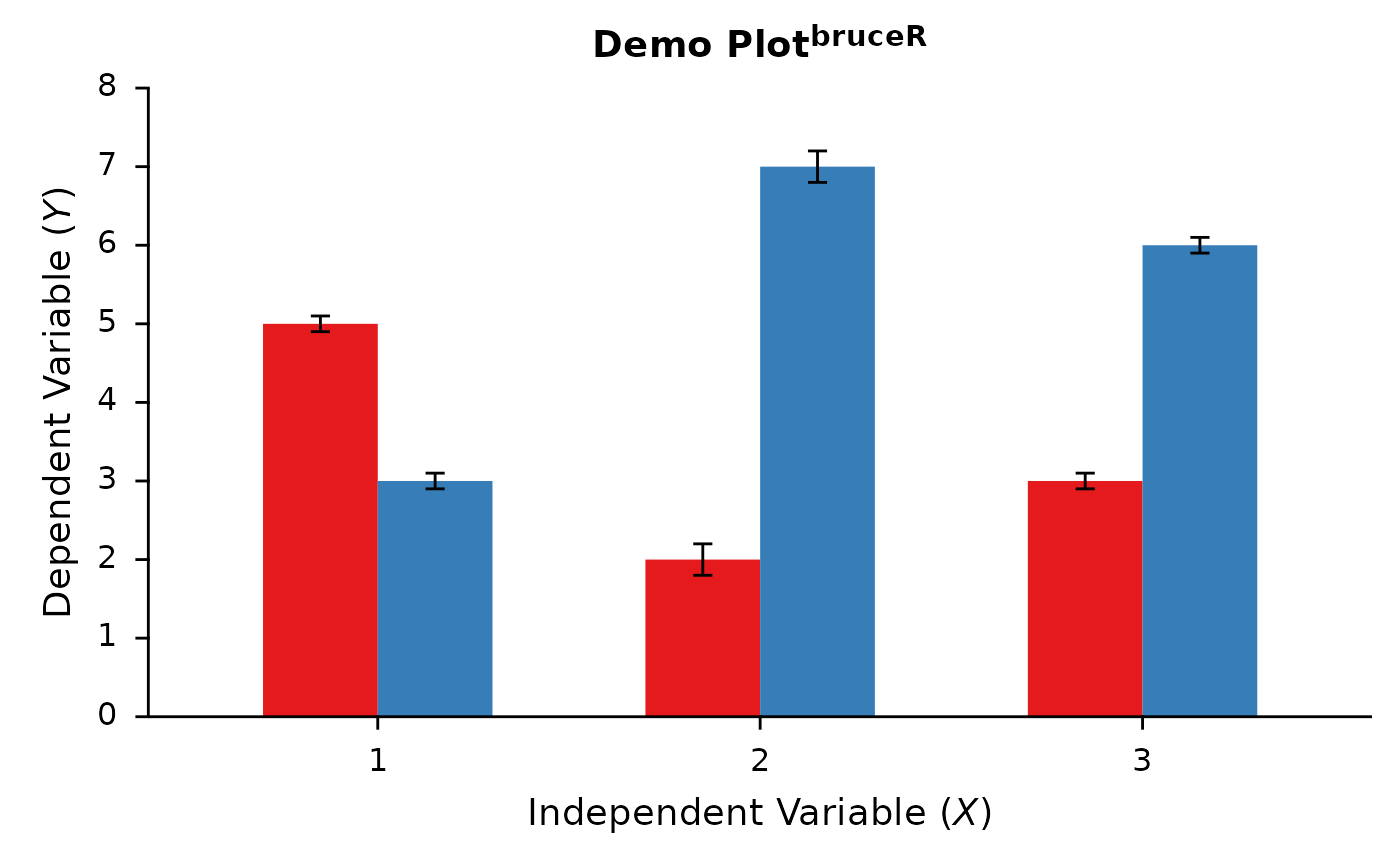
A nice ggplot2 theme that enables Markdown/HTML rich text.
Source: R/bruceR-stats_6_plot.R
theme_bruce.RdA nice ggplot2 theme for scientific publication. It also uses ggtext::element_markdown() to render Markdown/HTML formatted rich text. You can use a combination of Markdown and/or HTML syntax (e.g., "*y* = *x*<sup>2</sup>") in plot text or title, and this function draws text elements with rich text format.
For more usage, see:
Usage
theme_bruce(
markdown = FALSE,
base.size = 12,
line.width = 0.5,
border = "black",
bg = "white",
panel.bg = "white",
tag = "bold",
plot.title = "bold",
axis.title = "plain",
title.pos = 0.5,
subtitle.pos = 0.5,
caption.pos = 1,
font = NULL,
grid.x = "",
grid.y = "",
line.x = TRUE,
line.y = TRUE,
tick.x = TRUE,
tick.y = TRUE
)Arguments
- markdown
Use
element_markdown()instead ofelement_text(). Defaults toFALSE. If set toTRUE, then you should also useelement_markdown()intheme()(if any).- base.size
Basic font size. Defaults to
12.- line.width
Line width. Defaults to
0.5.- border
TRUE,FALSE, or"black"(default).- bg
Background color of whole plot. Defaults to
"white". You can use any colors or choose from some pre-set color palettes:"stata","stata.grey","solar","wsj","light","dust".- panel.bg
Background color of panel. Defaults to
"white".- tag
Font face of tag. Choose from
"plain","italic","bold","bold.italic".- plot.title
Font face of title. Choose from
"plain","italic","bold","bold.italic".- axis.title
Font face of axis text. Choose from
"plain","italic","bold","bold.italic".- title.pos
Title position (0~1).
- subtitle.pos
Subtitle position (0~1).
- caption.pos
Caption position (0~1).
- font
Text font. Only applicable to Windows system.
- grid.x
FALSE,""(default), or a color (e.g.,"grey90") to set the color of panel grid (x).- grid.y
FALSE,""(default), or a color (e.g.,"grey90") to set the color of panel grid (y).- line.x
Draw the x-axis line. Defaults to
TRUE.- line.y
Draw the y-axis line. Defaults to
TRUE.- tick.x
Draw the x-axis ticks. Defaults to
TRUE.- tick.y
Draw the y-axis ticks. Defaults to
TRUE.
Examples
## Example 1 (bivariate correlation)
d = as.data.table(psych::bfi)
added(d, {
E = .mean("E", 1:5, rev=c(1,2), range=1:6)
O = .mean("O", 1:5, rev=c(2,5), range=1:6)
})
ggplot(data=d, aes(x=E, y=O)) +
geom_point(alpha=0.1) +
geom_smooth(method="loess") +
labs(x="Extraversion<sub>Big 5</sub>",
y="Openness<sub>Big 5</sub>") +
theme_bruce(markdown=TRUE)
#> `geom_smooth()` using formula = 'y ~ x'
 ## Example 2 (2x2 ANOVA)
d = data.frame(X1 = factor(rep(1:3, each=2)),
X2 = factor(rep(1:2, 3)),
Y.mean = c(5, 3, 2, 7, 3, 6),
Y.se = rep(c(0.1, 0.2, 0.1), each=2))
ggplot(data=d, aes(x=X1, y=Y.mean, fill=X2)) +
geom_bar(position="dodge", stat="identity", width=0.6, show.legend=FALSE) +
geom_errorbar(aes(x=X1, ymin=Y.mean-Y.se, ymax=Y.mean+Y.se),
width=0.1, color="black", position=position_dodge(0.6)) +
scale_y_continuous(expand=expansion(add=0),
limits=c(0,8), breaks=0:8) +
scale_fill_brewer(palette="Set1") +
labs(x="Independent Variable (*X*)", # italic X
y="Dependent Variable (*Y*)", # italic Y
title="Demo Plot<sup>bruceR</sup>") +
theme_bruce(markdown=TRUE, border="")
## Example 2 (2x2 ANOVA)
d = data.frame(X1 = factor(rep(1:3, each=2)),
X2 = factor(rep(1:2, 3)),
Y.mean = c(5, 3, 2, 7, 3, 6),
Y.se = rep(c(0.1, 0.2, 0.1), each=2))
ggplot(data=d, aes(x=X1, y=Y.mean, fill=X2)) +
geom_bar(position="dodge", stat="identity", width=0.6, show.legend=FALSE) +
geom_errorbar(aes(x=X1, ymin=Y.mean-Y.se, ymax=Y.mean+Y.se),
width=0.1, color="black", position=position_dodge(0.6)) +
scale_y_continuous(expand=expansion(add=0),
limits=c(0,8), breaks=0:8) +
scale_fill_brewer(palette="Set1") +
labs(x="Independent Variable (*X*)", # italic X
y="Dependent Variable (*Y*)", # italic Y
title="Demo Plot<sup>bruceR</sup>") +
theme_bruce(markdown=TRUE, border="")
